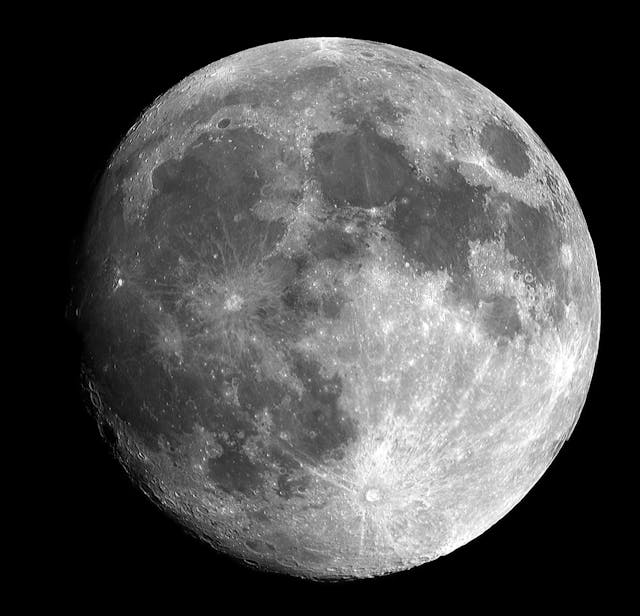
How do the phases of the moon happen? The phases of the moon happen because only one side of the moon faces the Earth at any one time and as the moon rotates we can’t see the lit side.
This question was surprisingly difficult for me to get my head around. For the longest time, I believed that the phases of the moon were caused by the shadow of the Earth. That is not true. There are several reasons why you can see that it can’t be true. If the Earth was casting a shadow on the moon, that shadow would become bigger and smaller throughout the day as the Earth and the moon moved. That doesn’t happen. Also, the Earth is only between the sun and the moon about four times a year. When this happens, you get a lunar eclipse, but only if there is a full moon at the same time. If there is no full moon, you wouldn’t be able to see the eclipse. Also, a solar eclipse doesn’t block out the moon as much as the moon phases do. Sunlight still comes through our atmosphere and makes the moon appear red, rather than black. The moon orbits the Earth once a month but the Earth doesn’t usually come between the sun and the moon because the moon’s orbit is tilted relative to the Earth’s orbit. So, what is causing the moon phases?
The first thing to understand is that the moon doesn’t orbit the Earth in one day. The moon rises and sets every day, so it is easy to believe that it orbits the Earth every day, but the moon takes 29.5 days to orbit the Earth. It appears as though it orbits quickly because the Earth is rotating under the moon. We rotate at a speed where it takes almost 24 hours to be back under the point where the moon was the night before.
The second thing to understand is that the moon is locked to the Earth’s orbit. Well, locked might be the wrong word. The moon orbits the Earth in 29.5 days and it takes the moon precisely 29.5 days to rotate once. That means the moon is rotating as it goes around the Earth at precisely the same rate it is going around the Earth, which means we only ever see one face of it. The far side of the moon never faces Earth. This is caused by something called tidal locking. When the moon was new, it used to rotate a lot faster and organisms on the Earth (this was way before any plants or animals) would have seen the far side of the moon if they had had eyes to look with. As the moon orbits the Earth, it experiences tidal forces from Earth’s gravity. That stretches and squeezes the moon and creates friction. This friction slowed down the moon’s rotation to the point where it turns once a month. It won’t go any slower and it won’t speed up because the gravity of the Earth is still there.
The third thing to understand is that the moon has a day and a night, just like Earth does. The moon rotates and the sun illuminates different parts of it, just as Earth does. Except, it takes 24 hours for us to go through one day night cycle and it takes the moon 29.5 days to go through the day night cycle. If you stood on the moon, it would take roughly 15 days for the sun to set and then rise again.
So, where do the phases of the moon come from? The easiest way to explain this it to think about a bicycle wheel, a basketball, and a very powerful flashlight. Let’s put a white piece of tape on one part of the wheel and spin it so it is rotating very quickly. This is our Earth. Then, we’ll take a white pen and write a big letter A on one face of the basketball. This is our moon. We’ll put the flashlight on a stand and point it at the wheel and the basketball. This is our sun. The flashlight is fully illuminating the side of the basketball with the A on it. This is a full moon. We are now going to move the basketball around the bicycle wheel, keeping the A pointing towards the bicycle wheel at all times. What do we notice? As we go round the first quarter of the wheel, the flashlight is now illuminating half of the A and the rest of the light goes across the side of the basketball. From Earth, we can only see the A, and half of the A face of the basketball is no longer illuminated by the flashlight. This is a quarter moon. As we keep moving the basketball round the wheel, keeping the A side of the ball towards the wheel, the flashlight illuminates less and less of the A side and more and more of the back side. We get to a point where none of the A side is illuminated, and this is a new moon. The moon is there, we just can’t see it because the moon’s daylight is on the far side, which never faces us. Then, as we keep moving the ball around the wheel, keeping the A pointing towards the wheel, the sunlight slides back round to the front, and this is a quarter moon and then a full moon again.
I’m sure you don’t have as much trouble getting your head around this as I did, but it really helped me trying to get it down on paper. The youtube video in the sources is a great visual representation and helped a lot. And that is what I learned today.
Sources
https://science.howstuffworks.com/moon4.htm
https://en.wikipedia.org/wiki/Lunar_phase
Photo by Pixabay: https://www.pexels.com/photo/photo-of-moon-47367/
